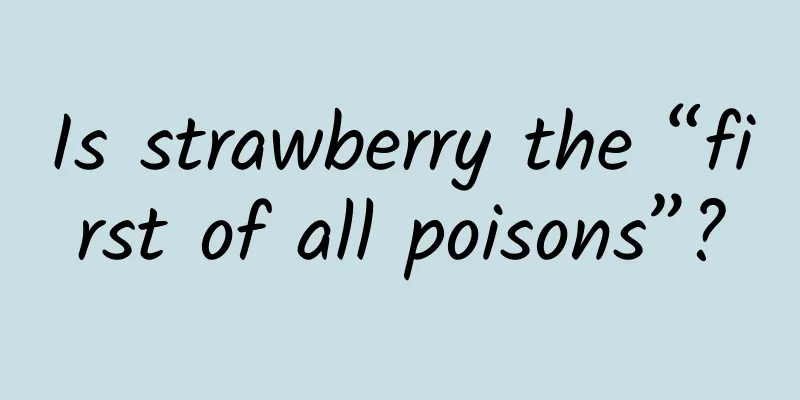Is strawberry the “first of all poisons”?

|
Every year during the strawberry season, some media videos claim that strawberries need to be treated with a variety of pesticides and even veterinary antibiotics from seedling to harvest, and that strawberries are inedible. These videos continue to circulate, attracting public attention and causing concern among many netizens. In this regard, the China Food Rumor Refutation and Science Popularization Alliance interviewed relevant experts from the Agricultural Product Quality Safety Risk Assessment Laboratory (Hangzhou) of the Ministry of Agriculture and Rural Affairs and the Institute of Agricultural Product Quality Safety and Nutrition of Zhejiang Academy of Agricultural Sciences, including Wang Qiang, Wu Shenggan, and Zhao Xueping. The experts unanimously stated that much of the content in the video is not true, which is likely to cause consumers to worry and worry, leading to a decline in consumer confidence and seriously affecting the development of the strawberry industry. Is strawberry the "first of all poisons"? Is it normal to have pesticide residues in strawberries? Can we still eat strawberries if multiple pesticide residues are detected? Let's see how experts answer questions and resolve doubts for the public. Is the shape of strawberry seeds related to frequent pesticide spraying? According to a video posted on a self-media platform on the Internet, the grains (actually seeds or seeds) on natural strawberries are bulging, while on strawberries that are frequently sprayed with pesticides, each seed is concave. The deeper the concave, the more times the pesticides have been sprayed. Experts refute rumors: This statement is completely wrong. The position of the strawberry seeds on the surface of the fruit is actually an external characteristic of the strawberry variety. Some strawberry varieties (such as "Yuexiu") have seeds protruding from the surface, but some varieties (such as "Yuexin") have seeds recessed into the surface. This has nothing to do with whether or how many times pesticides are sprayed. Can veterinary antibiotics such as penicillin potassium improve the resistance of strawberries? Some videos claim that many farmers now use antibiotics on strawberries to improve their resistance, but it is not clear whether they are improving disease resistance or drug resistance. Experts refute rumors: This statement is wrong. Veterinary antibiotics are used to prevent and treat animal diseases caused by bacterial invasion, such as potassium penicillin for respiratory infections, swine erysipelas, etc. However, most of the important diseases in strawberry production are fungal diseases. It is useless to use antibiotics that prevent bacteria to prevent fungi, not to mention improving disease resistance, and it is impossible to improve drug resistance. Even if a bacterial disease called "hollow disease" occurs in strawberries, it can be prevented and treated with pesticides that can kill bacteria such as zinc thiazole, but antibiotics such as potassium penicillin cannot be used, because my country has long stipulated that antibiotics cannot be used as pesticides on crops. Before transplanting strawberry seedlings, farmers will use herbicides such as paraquat to weed and seal the land? Some videos show that before transplanting strawberry seedlings, many farmers will spray herbicides to remove all weeds, which is called sealing the land. Experts refute rumors: When planting strawberries, if herbicides are used to weed and seal the ground before transplanting the strawberry seedlings, the strawberry seedlings can be free from weed damage after they are established. This is much more efficient than manual weeding and saves costs. Therefore, closed herbicides such as butachlor are more commonly used in actual production. At present, only two herbicides, betachlor and betachlor, for foliar spray on strawberries have obtained national pesticide registration, while other herbicides such as butachlor have not yet been allowed for use on strawberries, especially paraquat herbicide, which has been banned in my country. At present, clean cultivation is advocated in strawberry production. Most growers use mulch to suppress weeds and prevent strawberries from contacting the soil and causing pollution, ensuring the quality and safety of strawberries. Experts suggest, "If you find that growers use banned pesticides such as paraquat, you must report it to law enforcement agencies and provide relevant clues." Do we need to apply pesticides many times when growing strawberries? And they are highly toxic pesticides? Experts refute rumors: During the growing period, strawberries are often harmed by more than 20 major diseases and pests, causing serious consequences such as seedling death, yield reduction or even complete failure, although biological control and physical control are the first choice to reduce these diseases and pests. Experts said that the use of pesticides on strawberries is normal. At present, there are 132 registered pesticides allowed for use on strawberries in my country, involving 58 active ingredients, 90 manufacturers and 14 dosage forms. These pesticides are approved for use only after scientific tests have proven their efficacy and safety. As long as they are used according to the standards or label instructions, there will be no safety issues. This is like if a person is sick, he needs to take medicine. As long as you take the medicine according to the doctor's advice or label instructions, you don't have to worry. The two are the same. Since strawberries can be attacked by multiple pests and diseases at the same time during the planting process, and different pests and diseases require different pesticides to control, it is normal to mix 2 to 3 pesticides together. However, some videos say that "strawberries need to be sprayed with pesticides at least 8 to 10 times, with at least 6 to 7 kinds of pesticides each time." This phenomenon should not be common. In fact, strawberries are mainly sprayed with pesticides during the seedling stage, and rarely after flowering, because there are bees in the greenhouse for pollination. If the pesticides are used improperly, they are likely to cause harm to the bees, which is not worth the loss. Some videos also claim that many farmers have to use various drugs to prevent and control root rot, and also use various pesticides, which are very toxic. Pesticide bottles with skulls painted on them appear in the video. Experts believe that in recent years, as my country has stepped up its efforts to crack down on food safety violations, the use of highly toxic pesticides on fruits such as strawberries has been basically eliminated. my country's "Regulations on Pesticide Management" and other laws have long stipulated that it is strictly forbidden to use highly toxic and extremely toxic pesticides on fruits and vegetables, tea, fungi, and Chinese herbal medicines. If someone secretly uses highly toxic or extremely toxic pesticides in violation of the ban, once verified, they will be severely punished and even held criminally liable in accordance with the law. Is strawberry the "king of all poisons"? Is it normal to find pesticide residues in strawberries? A lot of pesticide residues were detected in strawberries. Can we still eat them? Experts refute rumors: The growth of strawberries cannot be separated from the use of pesticides, and pesticide residues are an inevitable phenomenon after the application of pesticides. The growth period of strawberries is very long, and the seedling cultivation can be as long as 7 months, and the period from transplanting to harvesting is also as long as 3 to 8 months. If pesticides are applied before flowering, especially during the seedling stage, the pesticides remaining on the strawberry plants will be greatly reduced after being exposed to wind, rain, sunlight and biodegradation. However, with the continuous advancement of pesticide residue detection technology, if a certain pesticide is used on strawberries, even if the residue is extremely low or even trace, it will be detected. Therefore, it is normal to detect pesticide residues. Experts suggest: To ensure people's health and safety, each country has strict pesticide residue limit standards to control pesticide residues in agricultural products within a safe range. my country has established maximum residue limits for 177 types of pesticides in strawberries, which basically cover the relevant pesticides used in strawberry production. Even if the pesticide residue exceeds the limit, it cannot be said that it is definitely unsafe. The key is the degree of the exceedance. When formulating pesticide residue limit standards, countries generally increase the safety factor by at least 100 times. |
Recommend
The "American consensus" on blockchain has been formed: embrace technology instead of blocking it
The United States is already taking drastic actio...
How to resolve the problem of Douyin Blue V certification failure and get a refund? What should I do if the Douyin Blue V certification fails?
Blue V is a service function specially developed ...
Calendar: Holidays over Body: No, not yet
The Spring Festival holiday was like a tornado Th...
I'm going to share 48 tricks to attract fans. If you don't have fans anymore, you can only blame yourself.
I'm going to share 48 tricks to attract traff...
Lost "Life": Reflections on the significance of scientific and technological progress
With the advancement of science and technology, e...
Toutiao account operation guide!
How to place advertisements on Toutiao? How to op...
BAT and other companies are working together to eliminate traditional TV brands from the smart TV industry
An industry field that is collectively favored an...
The 4G version of iPhone 12 is a "must-have" for consumers, and it is also Apple's "firefighter"
In the past, if Apple wanted to sell well, it alw...
After analyzing 100 FansTong delivery cases, I summarized 6 FansTong customer acquisition routines!
It’s time to share with you our nearly 10 years o...
up to date! An inventory of the characteristics of channels such as Tik Tok, Tencent, and Weibo!
“How do I optimize my account?” “How to solve the...
No creativity in video promotion? This article teaches you!
Since the second quarter of 2018, the education i...
[Summer 2021] Senior 3 English target A+ Quinny
[Summer 2021] Senior 3 English target A+ Quinny 【...
The most comprehensive APP promotion and operation methodology!
APP promotion is a big proposition. To do a good ...
How much does a box of Niraparib cost? How much does a box of Niraparib cost?
How much does a box of Niraparib cost? How much d...
Marketing promotion: 10 ways to easily carry out marketing activities!
When it comes to how to conduct marketing activit...









